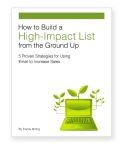2 Secrets to (Even More) Email Marketing Success
For several years now, various news sources have been reporting on the imminent demise of email.
With culprits running the gamut from spam to social media, email has definitely been marked for doom.
Why is that?
Sometimes I think these stories are written by disgruntled marketers who gave email a half-hearted whirl and were disappointed by the results.
Or maybe some people just have something personal against email—social media marketers, perhaps?
Or, all conspiracies aside, maybe they just want to sell more papers.
Whatever the reason, I want to dispel the myth right here and right now, because...
The rumors of email’s death have been largely exaggerated!
Not only does email continue to generate superior ROIs—over 4000%, on average—Forrester Research shows investment in email marketing is expected to grow at a compound annual growth rate of 10% between now and 2016.
However, it’s still true that a lack of planning can spell failure for even the biggest of budgets. But the addition of just two simple ingredients can change all that.
What are they?
Goals and segments.
Maybe this sounds like the sequel to Chutes and Ladders, but goals and segments are really just your keys to defining both what you want and what you need to deliver to get what you want.
So how does this work?
First, define your goal.
One of the simplest ways to define the goal of an email marketing program is to ask yourself what your primary sales goal is, and then simply align your email with those goals.
For example, if your primary goal is acquiring new customers, then your primary objective with your email program should be generating leads and getting referrals.
But if your main goal is to get existing customers to purchase even more—and preferably more expensive—products or services, then your email should focus on promoting other products and cultivating loyalty.
Second, segment your list.
Once your goals are in place, it’s time to segment your list.
There are four types of information used to segment a list:
- Endemic data
- Transactional data
- Behavioral data
- Computed data
As the people with the most face time with your customers, they’re in a position to know more about your prospects than anyone else—and their input is free.
As your house list grows, you’ll continue to learn more and more about the buying habits and preferences of your audience—valuable information you can then use to further refine your segmentation.
To illustrate this, let's say you’re sending out an autoresponder series and someone responds to one of the emails.
This should be a trigger to remove that person from the remainder of the series.
Likewise, the action they take after responding to your email will determine the segment you put them in next.
For example, if they’re still not ready to buy, you may decide to group them with another segment of your lead nurturing campaign.
Or you may decide (depending on where they are in your sales cycle) to remove them entirely from the campaign—choosing instead to follow up on a one-on-one basis.
And don’t forget to segment your inactive subscribers, too.
Even though it may seem at first glance that these inactive members of your list are simply dead leads, it’s very possible to reactivate many of these subscribers using lead nurturing emails designed specifically for them.
The above tips aren’t just for large companies. While some segmentation methods are certainly more complex than others, even small companies with limited budgets can put many of these techniques to work quite easily.
So in case somewhere along the way you decided email wasn’t for you—or if you currently have an email marketing program and it isn’t quite getting the results you’d hoped for—I invite you to take another look at both goal setting and segmentation.
Because compared to all other marketing channels, email is still the one to beat. And knowing what you want out of it and who your target audience is are crucial steps to helping you get where you want to go.
Return to articles




